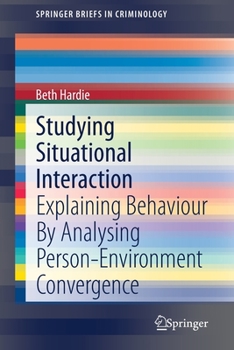Studying Situational Interaction: Explaining Behaviour by Analysing Person-Environment Convergence
- Abstract
- People, places and acts of crime
o The problematic dichotomy of criminology
o Aggregations of crime and acts of crime: The problematic level of explanation
o The problematic dichotomised study of crime events
o Why integrate people and places to explain action?
- Person-environment integration: How?
o The additive and interactive worldviews
o Approaches to criminological research
o Interaction, explanation, prevention
- Summary: Advocating an analytic criminology of person-environment interaction in acts of crime for effective prevention
- References
Chapter 2: Integrating individuals and environments: A Situational approach to studying action- Abstract
- Lacking an integrative model of action
- Studying dependency
- Integrative models of acts of crime
o Situational Action Theory and the situational model
o 'Situation', 'environment' and 'setting'
- Studying convergence: New approach, new methods
o Exposure
o Summary
- Appendix: Clarity of definitions and concepts: 'situation', 'environment' and 'setting'
o Conceptual ambiguity in psychology
o Conceptual conflation in criminology
o 'Situation' in criminology: Historical context of a misnomer
- References
Chapter 3: Evidencing situational interaction without situation-level exposure data- Abstract
- Making do without situation-level exposure data
- Interaction (dependence) in regression models
- Solving the problematic distribution of crime
o Non-linear models
o Transformation of the dependent variable
o OLS regression plus safeguards
- Reliability and interpretation
o Significance
o Comparing groups to access meaning
- Conclusion- References
Chapter 4: Collecting and analysing situation-level exposure data: Clarifying appropriate analysis of the convergence of people in environments to explain action- Abstract
- Designing situational research- Collecting situation-level exposure data
o Space-Time Budgets
o Randomised Scenarios
o Future methodological avenues
- Analysing situation-level exposure datao Additive Analysis
o Situational Analysis
o Evaluating approaches to





